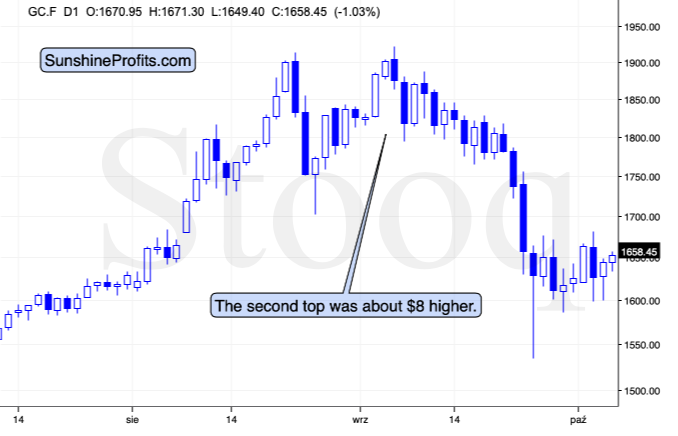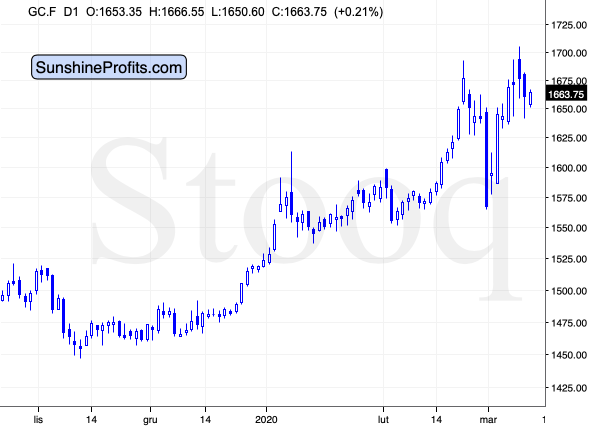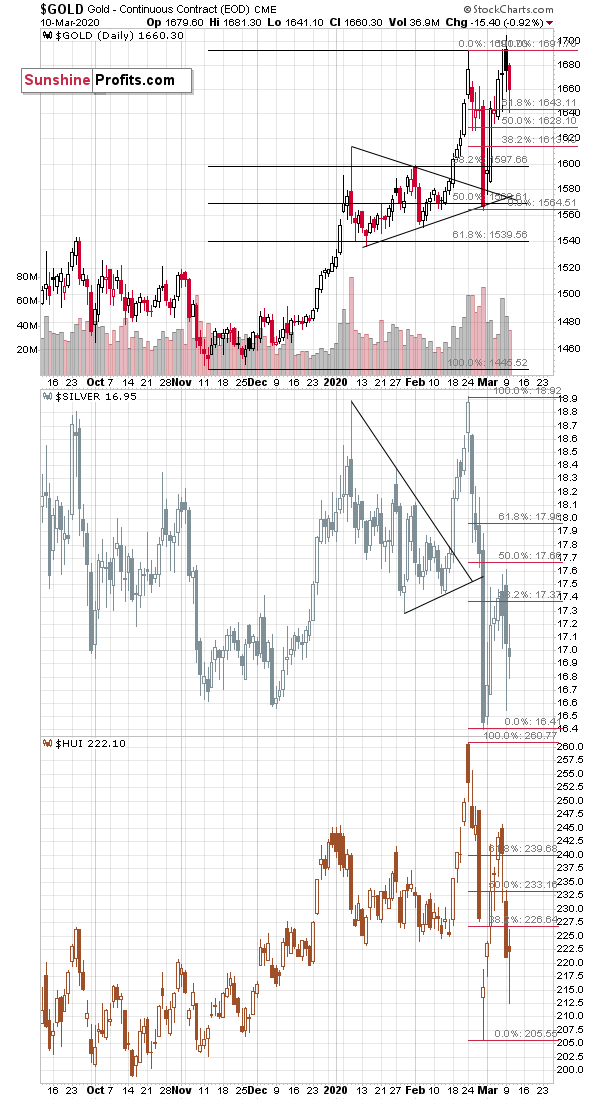Briefly: in our opinion, full speculative short positions (250% of the regular position size) in gold, silver, and mining stocks are justified from the risk/reward point of view at the moment of publishing this Alert.
In yesterday's Alert, we wrote about the current situation being similar not only to 2008 due to stocks' decline and a major downturn in the interest rate trajectory, but also to how gold topped in 2011.
Today, we would like to continue this discussion, because gold is so far behaving exactly as it behaved in 2011.
In yesterday's analysis, we wrote the following about gold's performance in 2011:
Gold plunged significantly initially - by about 11% - after which it rallied back up and topped about $8 above the previous high. It declined on the day that it reached this new intraday high, and it also declined on the following day.
What happened this year?
Gold plunged significantly initially - by about 7.5% - after which it rallied back up and topped $12.60 above the previous high. It declined on the day it reached this new intraday high (yesterday), and it's also declining on the following day (today).
Identical cases? No. Very similar? Definitely.
But there's more.
In both cases, silver was already after a major top a few months earlier, and it didn't move to new highs when gold did. Neither at THE top in gold, nor at its second top.
Miners were underperforming gold back in 2011, and they are underperforming it right now.
There are many similarities of the current situation in the precious metals market and in the markets in general to 2008, however, there are also quite clear analogies to how gold topped in 2011.
If this similarity continues (it might, but it might not be overly similar, only somewhat), then we can expect gold to decline at a slower pace to the first notable high. In this case, this would be the January 2020 high, when gold was trying to break above $1,600. That seems to be the analogy to the time, when gold tried to break above $1,800 in 2011. Gold would be likely to move back and forth around this level for a few days, and then to break below it in a dramatic fashion. Back in 2011, gold then declined almost twice as much as it did during the initial slide. The similar decline this time, should take gold to about $1,500.
The 2011 slide was particularly huge in case of silver - a move to the 2015 lows would not be out of the question.
And what happened next? Exactly what had happened in 2011.
Gold declined yesterday, reversed some of its declines, and today it's moving a bit (compared to previous volatile moves) higher.
This means that the analogy to the 2011 top with all its extremely bearish implications remains in place.
Gold and silver erased their early declines before the session was over, but that's not necessarily bullish.
Both: silver, and mining stocks declined previously along with the declining stock market. Since the stock market rallied back up yesterday and closed the day almost 5% higher, silver and miners could have moved back up along with it. They didn't - they just failed to slide further.
When gold declines along with stocks, silver and miners are likely to be hit particularly hard. And that's what we expect to happen. So, if you've been wondering which parts of the precious metals sector are likely to decline the most, we would still choose silver and mining stocks. There's huge downside potential in palladium because it rallied so significantly yesterday, but this market is also less predictable as it moves relatively separately from the key PMs.
Summary
Summing up, the 2020 top in the precious metals market is most likely in. Gold declined on record-breaking volume, while silver and miners plunged to new yearly lows - and it happened even before the USD's rally resumed. During the rebound, silver and mining stocks continued to show weakness. The outlook for the following months is extremely bearish, especially that even gold failed to really react to what happened recently. All of the following factors: dramatic increase in the fear of coronavirus, crude oil turmoil, and an extreme shift in market's expectations regarding interest rates, should have caused gold to soar, and the only thing that it was able to do, was to test its recent highs.
On one hand, the situation is similar to what happened in 2008 - the Fed is trying desperately to cut rates and prevent the market from sliding, and it's not really working. On the other hand, there are very visible similarities to how gold performed at and immediately after its 2011 top. Implications of both analogies are very bearish for the following weeks and months.
The profits on our big short position in the precious metals market are already sizable (not in gold, but they are huge in case of the silver and miners), and they are likely to become enormous in the following weeks.
As always, we'll keep you - our subscribers - informed.
To summarize:
Trading capital (supplementary part of the portfolio; our opinion): Full speculative short positions (250% of the full position) in gold, silver, and mining stocks are justified from the risk/reward perspective with the following stop-loss orders and binding exit profit-take price levels:
- Gold futures: profit-take exit price: $1,422; stop-loss: $1,712; initial target price for the DGLD ETN: $33.30; stop-loss for the DGLD ETN: $19.88
- Silver futures: profit-take exit price: $14.63; stop-loss: none (if gold moved to $1,712 we would view silver positions as no longer valid); initial target price for the DSLV ETN: $26.10; stop-loss for the DSLV ETN: none (if gold moved to $1,712 we would view silver positions as no longer valid)
- Mining stocks (price levels for the GDX ETF): profit-take exit price: $20.22; stop-loss: $29.51; initial target price for the DUST ETF: $11.29; stop-loss for the DUST ETF $4.25
In case one wants to bet on junior mining stocks' prices, here are the stop-loss details and target prices:
- GDXJ ETF: profit-take exit price: $28.32; stop-loss: $42.12
- JDST ETF: profit-take exit price: $20.97; stop-loss: $7.84
Long-term capital (core part of the portfolio; our opinion): No positions (in other words: cash)
Insurance capital (core part of the portfolio; our opinion): Full position
Whether you already subscribed or not, we encourage you to find out how to make the most of our alerts and read our replies to the most common alert-and-gold-trading-related-questions.
Please note that the in the trading section we describe the situation for the day that the alert is posted. In other words, it we are writing about a speculative position, it means that it is up-to-date on the day it was posted. We are also featuring the initial target prices, so that you can decide whether keeping a position on a given day is something that is in tune with your approach (some moves are too small for medium-term traders and some might appear too big for day-traders).
Plus, you might want to read why our stop-loss orders are usually relatively far from the current price.
Please note that a full position doesn't mean using all of the capital for a given trade. You will find details on our thoughts on gold portfolio structuring in the Key Insights section on our website.
As a reminder - "initial target price" means exactly that - an "initial" one, it's not a price level at which we suggest closing positions. If this becomes the case (like it did in the previous trade) we will refer to these levels as levels of exit orders (exactly as we've done previously). Stop-loss levels, however, are naturally not "initial", but something that, in our opinion, might be entered as an order.
Since it is impossible to synchronize target prices and stop-loss levels for all the ETFs and ETNs with the main markets that we provide these levels for (gold, silver and mining stocks - the GDX ETF), the stop-loss levels and target prices for other ETNs and ETF (among other: UGLD, DGLD, USLV, DSLV, NUGT, DUST, JNUG, JDST) are provided as supplementary, and not as "final". This means that if a stop-loss or a target level is reached for any of the "additional instruments" (DGLD for instance), but not for the "main instrument" (gold in this case), we will view positions in both gold and DGLD as still open and the stop-loss for DGLD would have to be moved lower. On the other hand, if gold moves to a stop-loss level but DGLD doesn't, then we will view both positions (in gold and DGLD) as closed. In other words, since it's not possible to be 100% certain that each related instrument moves to a given level when the underlying instrument does, we can't provide levels that would be binding. The levels that we do provide are our best estimate of the levels that will correspond to the levels in the underlying assets, but it will be the underlying assets that one will need to focus on regarding the signs pointing to closing a given position or keeping it open. We might adjust the levels in the "additional instruments" without adjusting the levels in the "main instruments", which will simply mean that we have improved our estimation of these levels, not that we changed our outlook on the markets. We are already working on a tool that would update these levels on a daily basis for the most popular ETFs, ETNs and individual mining stocks.
Our preferred ways to invest in and to trade gold along with the reasoning can be found in the how to buy gold section. Additionally, our preferred ETFs and ETNs can be found in our Gold & Silver ETF Ranking.
As a reminder, Gold & Silver Trading Alerts are posted before or on each trading day (we usually post them before the opening bell, but we don't promise doing that each day). If there's anything urgent, we will send you an additional small alert before posting the main one.
Thank you.
Sincerely,
Przemyslaw Radomski, CFA
Editor-in-chief, Gold & Silver Fund Manager






